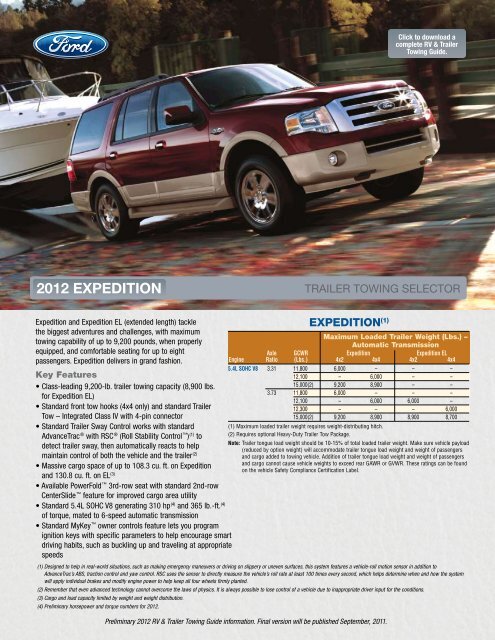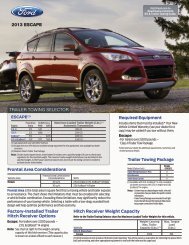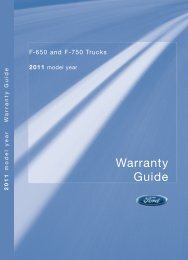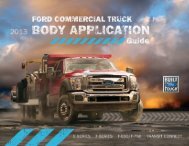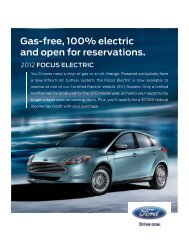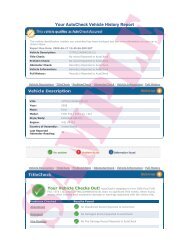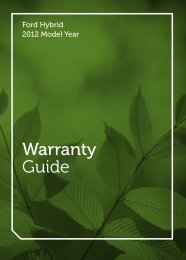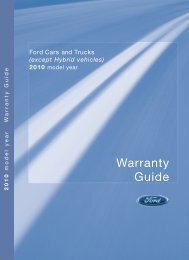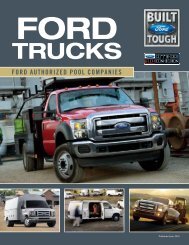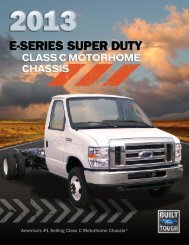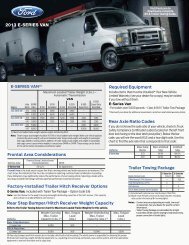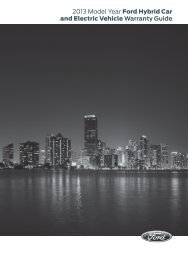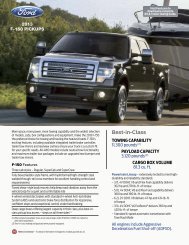Expedition Towing Guide - Ford
Expedition Towing Guide - Ford
Expedition Towing Guide - Ford
Create successful ePaper yourself
Turn your PDF publications into a flip-book with our unique Google optimized e-Paper software.
Click to download a<br />
complete RV & Trailer<br />
<strong>Towing</strong> <strong>Guide</strong>.<br />
2012 EXPEDITION Trailer <strong>Towing</strong> SelecTor<br />
<strong>Expedition</strong> and <strong>Expedition</strong> EL (extended length) tackle<br />
the biggest adventures and challenges, with maximum<br />
towing capability of up to 9,200 pounds, when properly<br />
equipped, and comfortable seating for up to eight<br />
passengers. <strong>Expedition</strong> delivers in grand fashion.<br />
Key Features<br />
• Class-leading 9,200-lb. trailer towing capacity (8,900 lbs.<br />
for <strong>Expedition</strong> EL)<br />
• Standard front tow hooks (4x4 only) and standard Trailer<br />
Tow – Integrated Class IV with 4-pin connector<br />
• Standard Trailer Sway Control works with standard<br />
AdvanceTrac ® with RSC ® (Roll Stability Control ) (1) to<br />
detect trailer sway, then automatically reacts to help<br />
maintain control of both the vehicle and the trailer (2)<br />
• Massive cargo space of up to 108.3 cu. ft. on <strong>Expedition</strong><br />
and 130.8 cu. ft. on EL (3)<br />
• Available PowerFold 3rd-row seat with standard 2nd-row<br />
CenterSlide feature for improved cargo area utility<br />
• Standard 5.4L SOHC V8 generating 310 hp (4) and 365 lb.-ft. (4)<br />
of torque, mated to 6-speed automatic transmission<br />
• Standard MyKey owner controls feature lets you program<br />
ignition keys with specific parameters to help encourage smart<br />
driving habits, such as buckling up and traveling at appropriate<br />
speeds<br />
(1) Designed to help in real-world situations, such as making emergency maneuvers or driving on slippery or uneven surfaces, this system features a vehicle-roll motion sensor in addition to<br />
AdvanceTrac’s ABS, traction control and yaw control. RSC uses the sensor to directly measure the vehicle’s roll rate at least 100 times every second, which helps determine when and how the system<br />
will apply individual brakes and modify engine power to help keep all four wheels firmly planted.<br />
(2) Remember that even advanced technology cannot overcome the laws of physics. It is always possible to lose control of a vehicle due to inappropriate driver input for the conditions.<br />
(3) Cargo and load capacity limited by weight and weight distribution.<br />
(4) Preliminary horsepower and torque numbers for 2012.<br />
EXPEDITION (1)<br />
Maximum Loaded Trailer Weight (Lbs.) –<br />
Automatic Transmission<br />
Axle GCWR <strong>Expedition</strong> <strong>Expedition</strong> EL<br />
Engine Ratio (Lbs.) 4x2 4x4 4x2 4x4<br />
5.4L SOHC V8 3.31 11,800 6,000 – – –<br />
12,100 – 6,000 – –<br />
15,000(2) 9,200 8,900 – –<br />
3.73 11,800 6,000 – – –<br />
12,100 – 6,000 6,000 –<br />
12,300 – – – 6,000<br />
15,000(2) 9,200 8,900 8,900 8,700<br />
(1) Maximum loaded trailer weight requires weight-distributing hitch.<br />
(2) Requires optional Heavy-Duty Trailer Tow Package.<br />
Note: Trailer tongue load weight should be 10-15% of total loaded trailer weight. Make sure vehicle payload<br />
(reduced by option weight) will accommodate trailer tongue load weight and weight of passengers<br />
and cargo added to towing vehicle. Addition of trailer tongue load weight and weight of passengers<br />
and cargo cannot cause vehicle weights to exceed rear GAWR or GVWR. These ratings can be found<br />
on the vehicle Safety Compliance Certification Label.<br />
Preliminary 2012 RV & Trailer <strong>Towing</strong> <strong>Guide</strong> information. Final version will be published September, 2011.
If you are selecting a vehicle that will be used for towing, you<br />
should determine the approximate weight of the trailer you intend<br />
to tow, including the weight of any additional cargo and fluids that<br />
you will be carrying in the trailer. Also be sure the vehicle has the<br />
proper optional equipment. Keep in mind that performance can be<br />
severely compromised in hilly terrain when minimum acceptable<br />
powertrain combination is selected. Consider purchasing a vehicle<br />
with a more powerful engine.<br />
BRAKES<br />
Many states require a separate braking system on trailers with a<br />
loaded weight of more than 1,500 pounds. For your safety, <strong>Ford</strong> Motor<br />
Company recommends that a separate functional brake system be<br />
used on any towed vehicle, including those dolly-towed or towbartowed.<br />
There are several basic types of brake systems designed to<br />
activate trailer brakes:<br />
1. Electronically Controlled Brakes usually provide automatic and<br />
manual control of trailer brakes. They require that the tow vehicle<br />
be equipped with a controlling device and additional wiring for<br />
electrical power. These brakes typically have a control box<br />
installed within reach of the driver and can be applied manually<br />
or automatically.<br />
2. Electric-Over-Hydraulic (EOH) Trailer Brakes are operated by<br />
an electrically powered pump that pressurizes a hydraulic fluid<br />
reservoir built into the trailer’s brake system. Many of the available<br />
EOH trailer brake models are compatible with <strong>Ford</strong>’s factory<br />
installed, dash-integrated Trailer Brake Controller (TBC).<br />
3. Surge Brakes are independent hydraulic brakes activated by a<br />
master cylinder at the junction of the hitch and trailer tongue. They<br />
are not controlled by the hydraulic fluid in the tow vehicle’s brake<br />
system, and the tow vehicle’s hydraulic system should never be<br />
connected directly to the trailer’s hydraulic system.<br />
Be sure your trailer brakes conform to all applicable state regulations.<br />
See Trailering Tips for additional braking information.<br />
What to knoW before you toW<br />
Before You Buy After You Buy<br />
Before heading out on a trip, check your vehicle’s Owner <strong>Guide</strong><br />
for break-in and severe-duty maintenance schedules (do not tow<br />
a trailer until your vehicle has been driven at least 500 miles).<br />
Be sure to have your fully-loaded vehicle (including passengers)<br />
and trailer weighed so as not to exceed critical weight limits. If<br />
any of these limits are exceeded, cargo should be removed from<br />
the vehicle and/or trailer until all weights are within the specified<br />
limits.<br />
TRAILER LAMPS<br />
Make sure the trailer is equipped with lights that conform to all<br />
applicable government regulations. The trailer lighting system should<br />
not be connected directly to the lighting system of the vehicle. See<br />
a local recreational vehicle dealer or rental trailer agency for correct<br />
wiring and relays for the trailer and heavy-duty flashers.<br />
SAFETY CHAINS<br />
• Always use safety chains when towing. Safety chains are used to<br />
retain connection between the towing and towed vehicle in the event<br />
of separation of the trailer coupling or ball<br />
• Use cross chains under the trailer tongue to prevent the tongue from<br />
contacting the ground if a separation occurs. Allow only enough slack<br />
to permit full turning – be sure they do not drag on the pavement<br />
• When using a frame-mounted trailer hitch, attach the safety chains<br />
to the frame-mounted hitch using the recommendations supplied by<br />
the hitch manufacturer<br />
• See your vehicle’s Owner <strong>Guide</strong> for safety chain attachment<br />
information<br />
• For rental trailers, follow rental agency instructions for hookup of<br />
safety chains<br />
TRAILER WIRING HARNESS<br />
• Some vehicles equipped with a factory-installed Trailer Tow Package<br />
include a trailer wiring harness and a wiring kit<br />
• This kit includes one or more jumper harnesses (to connect to your<br />
trailer wiring connector) and installation instructions<br />
Preliminary 2012 RV & Trailer <strong>Towing</strong> <strong>Guide</strong> information. Final version will be published September, 2011.<br />
3
<strong>Towing</strong> a trailer is demanding on your vehicle,<br />
your trailer and your personal driving skills.<br />
Follow some basic rules and you’ll tow more<br />
safely and have a lot more fun.<br />
Weight Distribution<br />
• For optimum handling and braking, the load must<br />
be properly distributed<br />
• Keep center of gravity low for best handling<br />
• Approximately 60% of the allowable cargo weight<br />
should be in the front half of the trailer and 40%<br />
in the rear (within limits of tongue load or king pin<br />
weight)<br />
• Load should be balanced from side-to-side to<br />
optimize handling and tire wear<br />
• Load must be firmly secured to prevent shifting<br />
during cornering or braking, which could result in a<br />
sudden loss of control<br />
Before Starting<br />
• Before setting out on a trip, practice turning,<br />
stopping and backing up your trailer in an area<br />
away from heavy traffic<br />
• Know clearance required for trailer roof<br />
• Check equipment (make a checklist)<br />
Backing<br />
• Back up slowly, with someone spotting near the<br />
rear of the trailer to guide you<br />
• Place one hand at bottom of steering wheel and<br />
move it in the direction you want the trailer to go<br />
• Make small steering inputs – slight movement of<br />
steering wheel results in much greater movement<br />
in rear of trailer<br />
Turning<br />
When turning, be sure to swing wide enough to allow<br />
trailer to avoid curbs and other obstructions.<br />
Braking<br />
• Allow considerably more distance for stopping with<br />
trailer attached<br />
• Remember, the braking system of the tow vehicle is<br />
rated for operation at the GVWR, not GCWR<br />
• If your tow vehicle is a F-150, F-Series Super<br />
Duty ® , or E-Series and your trailer has electric<br />
brakes, the optional Integrated Trailer Brake<br />
Controller (TBC) will help assure smooth, effective<br />
trailer braking by automatically proportioning the<br />
trailer braking to that of the towing vehicle<br />
• If your trailer starts to sway, apply brake pedal<br />
gradually. The sliding lever on the TBC should<br />
be used only for manual activation of trailer<br />
brakes when adjusting the gain. Misuse, such<br />
as application during trailer sway, could cause<br />
instability of trailer and/or tow vehicle<br />
<strong>Towing</strong> On Hills<br />
• Downshift the transmission to assist braking on<br />
steep downgrades and to increase power (reduce<br />
lugging) when climbing hills<br />
• With TorqShift ® transmission, select Tow/Haul Mode<br />
to automatically eliminate unwanted gear search<br />
when going uphill and help control vehicle speed<br />
when going downhill<br />
Trailering Tips<br />
Parking With A Trailer<br />
Whenever possible, vehicles with trailers should not<br />
be parked on a grade. However, if it is necessary,<br />
place wheel chocks under the trailer’s wheels,<br />
following the instructions below.<br />
• Apply the foot service brakes and hold<br />
• Have another person place the wheel chocks under<br />
the trailer wheels on the downgrade side<br />
• Once the chocks are in place, release brake pedal,<br />
making sure the chocks will hold the vehicle and<br />
trailer<br />
• Apply the parking brake<br />
• Shift automatic transmission into Park, or manual<br />
transmission into Reverse<br />
• With 4-wheel drive, make sure the transfer case is<br />
not in Neutral (if applicable)<br />
Starting Out Parked On A Grade<br />
• Apply the foot service brake and hold<br />
• Start the engine with transmission in Park<br />
(automatic) or Neutral (manual)<br />
• Shift the transmission into gear and release the<br />
parking brake<br />
• Release the brake pedal and move the vehicle<br />
uphill to free the chocks<br />
• Apply the brake pedal while another person<br />
retrieves the chocks<br />
Acceleration And Passing<br />
The added weight of the trailer can dramatically<br />
decrease the acceleration of the towing vehicle –<br />
exercise caution.<br />
• When passing a slower vehicle, be sure to allow<br />
extra distance. Remember, the added length of the<br />
trailer must clear the other vehicle before you can<br />
pull back in<br />
• Signal and make your pass on level terrain with<br />
plenty of clearance<br />
• If necessary, downshift for improved acceleration<br />
Driving With An Automatic<br />
Overdrive Transmission<br />
With certain automatic overdrive transmissions,<br />
towing – especially in hilly areas – may cause<br />
excessive shifting between overdrive and the next<br />
lower gear.<br />
• To eliminate this condition and achieve steadier<br />
performance, overdrive can be locked out (see<br />
vehicle Owner <strong>Guide</strong>)<br />
• If excessive shifting does not occur, use overdrive<br />
to optimize fuel economy<br />
• Overdrive may also be locked out to obtain engine<br />
braking on downgrades<br />
• When available, select Tow/Haul Mode to<br />
automatically eliminate unwanted gear search and<br />
help control vehicle speed when going downhill<br />
Driving With Speed Control<br />
When driving uphill with a heavy load, significant<br />
speed drops may occur.<br />
• An 8-14 mph speed drop will automatically cancel<br />
speed control<br />
• Temporarily resume manual control through the<br />
vehicle’s accelerator pedal until the terrain levels off<br />
Tire Pressure<br />
• Underinflated tires get hot and may fail, leading to<br />
possible loss of vehicle control<br />
• Overinflated tires may wear unevenly<br />
• Tires should be checked often for conformance to<br />
recommended cold inflation pressures<br />
Spare Tire Use<br />
A conventional full-size spare tire is required for trailer<br />
towing (mini spare tires should not be used; always<br />
replace the spare tire with the road tire as soon as<br />
possible).<br />
On The Road<br />
After about 50 miles, stop in a protected location and<br />
double-check:<br />
• Trailer hitch attachment<br />
• Lights and electrical connections<br />
• Trailer wheel lug nuts for tightness<br />
• Engine oil – check regularly throughout trip<br />
High Altitude Operation<br />
Gasoline engines lose power by 3-4% per 1,000 ft.<br />
elevation. To maintain performance, reduce GVWs and<br />
GCWs by 2% per 1,000 ft. elevation.<br />
Powertrain/Frontal Area<br />
Considerations<br />
The charts in this <strong>Guide</strong> show the minimum engine size<br />
needed to move the GCW of tow vehicle and trailer.<br />
• Under certain conditions, however, (e.g., when the<br />
trailer has a large frontal area that adds substantial<br />
air drag or when trailering in hilly or mountainous<br />
terrain) it is wise to choose a larger engine<br />
• Selecting a trailer with a low-drag, rounded front<br />
design will help optimize performance and fuel<br />
economy<br />
NOTE: For additional trailering information pertaining to your<br />
vehicle, refer to the vehicle Owner <strong>Guide</strong>.<br />
Photography, illustrations and information presented herein<br />
were correct when approved for printing. <strong>Ford</strong> Motor Company<br />
reserves the right to discontinue or change at any time the<br />
specifications or designs without incurring obligation. Some<br />
features shown or described are optional at extra cost. Some<br />
options are required in combination with other options. Consult<br />
your Dealer for the latest, most complete information on<br />
models, features, prices and availability.<br />
Many of the recreational vehicles shown in this brochure<br />
are modified or manufactured by companies other than<br />
<strong>Ford</strong> Motor Company. <strong>Ford</strong> assumes no responsibility for<br />
such modifications or manufacturing.<br />
Metric Conversion – To obtain information in centimeters, multiply feet by 30.48; to obtain information in<br />
kilometers, multiply miles by 1.6.<br />
For more vehicle information, please visit www.ford.com.<br />
Preliminary 2012 RV & Trailer <strong>Towing</strong> <strong>Guide</strong> information. Final version will be published September, 2011.


